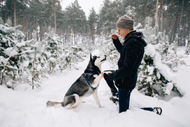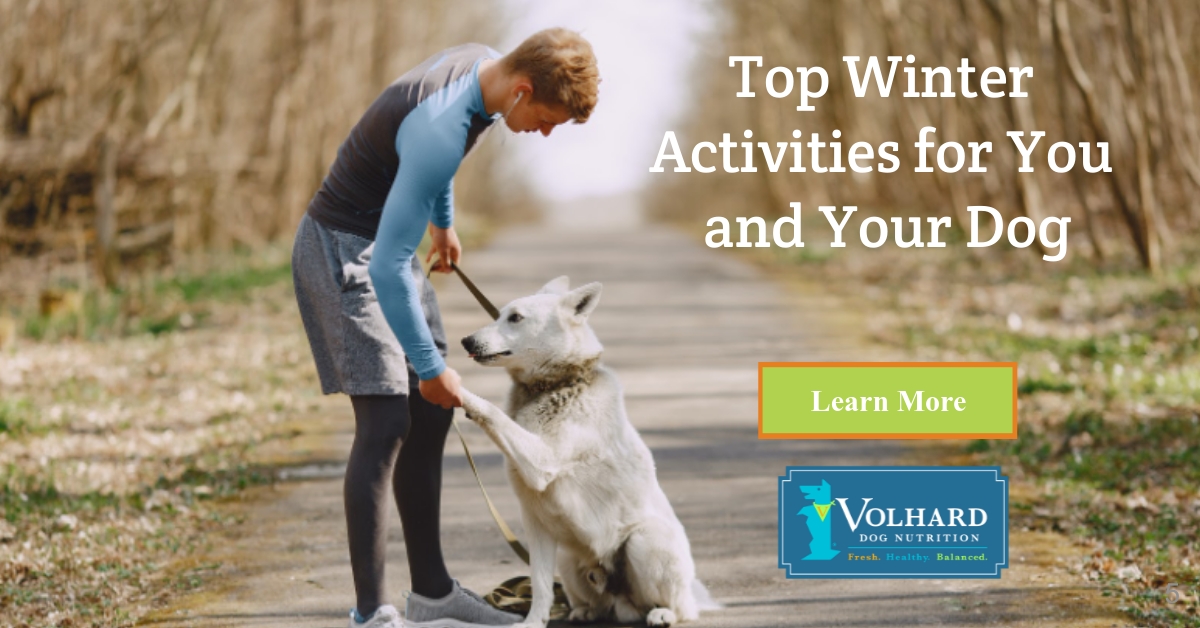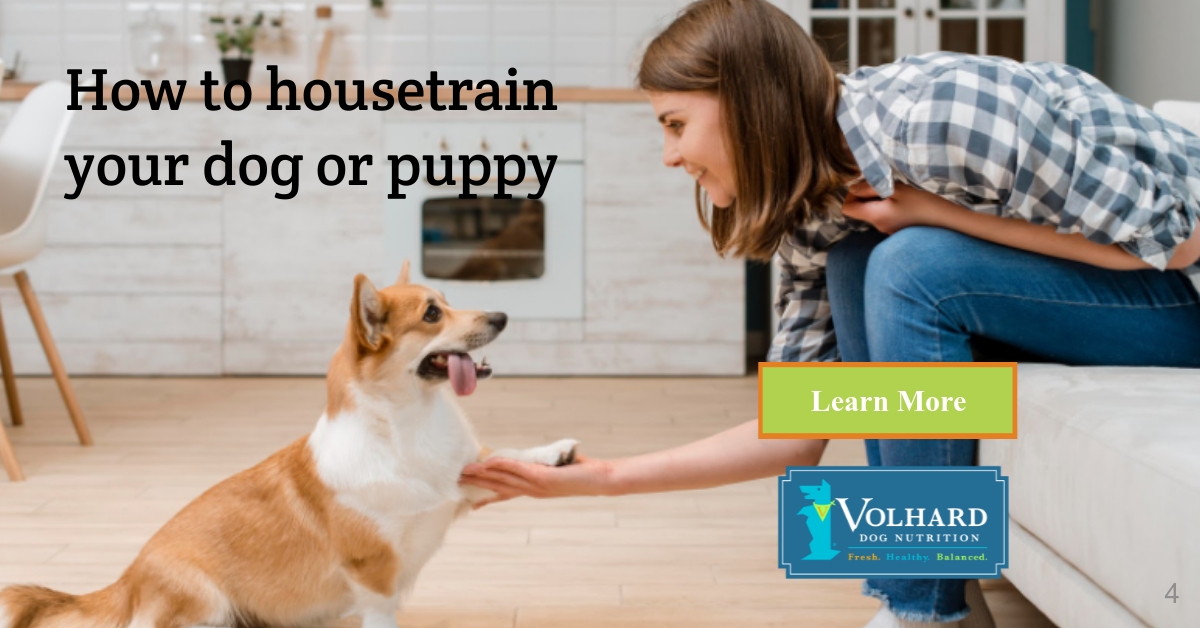Volhard's Top 9 Tips for Training Your Puppy During the Winter
Posted by Volhard Dog Nutrition on Feb 10th 2021
For both dogs and dog owners, winter is not always their cup of tea—snow and cold weather keep them confined in their homes by the warmth of the fire. Especially for dogs, this time of the year lacks the much-needed daily exercise, so important to their overall health.
However, just because the snow might be a bit cold for its paws, that does not mean your puppy can lay on the sleeping mat all day.
Both the body and the mind of a puppy need perpetual stimulation (we all know what happens when bored dogs meet the living room couch).
With that in mind, we think that until the arrival of spring, you need to buckle down and spend as much time with your puppy as possible (without becoming tedious), teaching him new tricks and how to interact with new textures and surfaces.
Not only will Puppy be prone to learning tricks that are more difficult during their adult life but also to be more curious and ready to overcome their fears right away!
The Benefits of Training Your Dog From an Early Age
Dog puppies, as well as infants, are curious creatures, and it’s your responsibility to feed that curiosity from an early age.
Whether through exercises or simply discovering new places, Puppy will get used to learning new things and gradually build up its curiosity and, most importantly, its confidence.
One of the biggest things for a puppy is to become familiar with new textures and surfaces under their feet.
This is the perfect moment for your puppy to learn how to walk on grass, rocks, etc., because, as they get older, dogs do not show the same amount of courage.
Creating an obstacle course with different textures teaches Puppy how to overcome its fear and feeds its curiosity.
In the end, it’s all about proactive thinking—every dog owner wants to have a happy and courageous canine companion!
However, that takes exercise and patience.
Furthermore, puppies need time to get acquainted with new things.
For example, allowing Puppy to take a nap during exercise time will be rewarded with increased interest and energy.
Now that we’ve looked through the benefits of training puppies from an early age, let’s discuss Volhard’s top 9 tips for training your puppy this winter!
#1: Helping Your Puppy Get Used to the Crate
Unsure how to begin?
Start your crate training.
For a dog, having a private space where they could rest and enjoy a bit of solitude is essential.
While, for some dogs, that place could be found under the couch, why not turn the crate into a fun, safe zone?
There comes a time in a dog’s life when they meet the crate, whether it’s for a vet appointment or traveling.
If Puppy is the outdoorsy type, crate time can be synonymous with punishment, but only if dog owners make it so.
Training tips:
- Gradually teach Puppy the Crate command.
- Once you put its meal into the crate, say “Crate.” Your puppy will gradually understand the link between the word and the crate, especially if you add treats and rewards.
- Don’t forget to keep its favorite toys inside the crate as an incentive.
#2: Regular Toilet Area
Another basic lesson for your puppy to learn is the designated toilet area.
Aside from the fact that dog owners don’t want accidents to happen on the living room carpet, designating an outdoor toilet area is a great opportunity for you and your puppy to spend time outside together.
However, don’t forget to always pick up after Puppy for sanitary reasons, even if they do their business in the loud neighbor’s yard.
Training tips:
- After selecting a toilet area, always take Puppy to that spot when it’s about to eliminate.
- Stand still, be patient, and let it sniff and do its business.
- When the process is over, reward your puppy with praises and attention.
- Make sure that you spend extra time outside playing—if it doesn’t get enough playtime, Puppy will delay the process on purpose or have an accident inside the house.
#3: Long Down
This is the perfect exercise to be taught for impulse control.
As soon as you bring your puppy home, the Long Down exercise teaches Puppy that you’re in charge, however, in a non-threatening way.
As a rule, puppies who learn this exercise from the start are more prone to learning additional commands and tricks.
Teaching this exercise in the evening, when Puppy is tired, is recommended.
Training tips:
- Use a treat to get Puppy to settle, and then kneel next to it, facing the same direction.
- Reach over its back and place your hand on its forelegs while making sure that you don’t squeeze your puppy’s legs.
- Lift the puppy into the begging position and lower it to the ground. If Puppy gets up, simply repeat the process.
- Repeat the process constantly for the first month until it becomes part of the routine.
#4: Down on Command
After learning the Long Down exercise, Puppy will know how to lie down.
However, how will it learn to lie down on command and wait until you release it?
Enter the Down on Command exercise!
Teaching this command to Puppy will come in handy, for example, when you need your canine friend to wait for a minute outside the grocery store.
Training tips:
- Position yourself on the dog’s right side while facing the same direction.
- With a treat in your right hand, place one or two fingers, through the collar, at the side of its neck.
- Lower the treat straight down in front of Puppy while applying mild pressure to the collar and saying “Down.”
- As Puppy is lying down, gently distance yourself from him and tell it to “Stay.”
- Repeat these commands until your furry friend learns them.
#5: Go Lie Down, Doggy!
A helpful command when you want Puppy to lay and wait in a designated spot (e.g., the dog bed, a blanket, etc.), for example, when you tidy up the house, or you have some guests for a party.
Training tips:
- Take Puppy to the designated area and give it the “Go lie down” command. You might have to use a treat if it gets too antsy.
- When Puppy lies down, reward him with praise and a treat.
- Repeat the process while gradually increasing the time between the praise and the treat.
Remember to release your furry friend from the spot. Otherwise, they will get into the habit of releasing itself while defeating the purpose of this exercise.
#6: Door Manners
If you’re afraid that Puppy might leave the house and get into trouble every time the front door is open, then teaching him some door manners will come in handy.
Training tips:
- Sit on Puppy’s right side while holding the leash close to their collar.
- Give the “Stay” command while gently opening the door. If your puppy shows signs of trying to exit, close the door.
- Repeat the process while opening the door a little wider each time.
- Gradually cross the threshold a bit more until Puppy learns the “Stay” command.
- Remember to praise Puppy every time they make progress.
- When you’re finally outside, give the “Stay” command and close the door behind you.
#7: Respect the Leash
Proper walking manners while on a leash is another good sign of a dog’s discipline.
If the weather outside is not helpful, for this exercise, choose an open and wide room inside the house.
Make sure that you hold the leash properly to avoid accidents.
Training tips:
- Use the “Let’s go” command and start walking.
- Right before Puppy gets at the end of the leash, give the “Let’s go” command, turn to your right and walk in the opposite direction.
- Praise Puppy as they rush to catch up with you.
- Repeat the process until Puppy properly responds to the “Let’s go” command.
- Gradually remove the “Let’s go” command as you make your turn.
- When Puppy is comfortable with the routine, get ready to introduce distractions.
#8: Respect the Leash: Adding Distractions
On the street, quite a few distractions will engross Puppy: squirrels, lizards, food carts, etc.
Your job is to remind your canine friend that you’re always the center of attention, regardless of the distractions.
Training tips:
- As you approach the distracter, give Puppy the “Let’s go” command and walk the other way.
- If they persevere in following the distracter, they will experience a tug on the leash.
- Repeat the process until Puppy successfully responds to your command, adding praises and treats.
#9: Come Command
It is the dog owners’ dream to have their canine companion show up on command.
To teach Puppy the “Come” command, all you need is to practice the Recall Game with him and a friend.
This game can easily be played around the house, as it doesn’t require too much space.
Make sure that you make the game more complicated by increasing the distance between you and Puppy and by adding distractions.
For a thorough description of the Recall Game, please check out our founder, Wendy Volhard’s Volhard Dog Training for Dummies book.
Conclusion
After looking at so many dog-training tips, it is safe to say that Puppy will have enough work to keep him busy during the winter season. Here at Volhard, we hope that our contribution will help foster a happy and healthy relationship between you and your puppy. Are you looking for more exciting ideas? Feel free to contact us or check out our blog!
Volhard Dog Nutrition and its expert nutritionists are now offering online consultations to help more dog parents discover why, what, and how to feed their dogs the healthiest of foods! Speaking to a Volhard nutritionist will help you understand the inseparable relationship between healthy food, a healthy body, and a healthy mind. If you're interested in contacting one of our Volhard nutritionists, don't hesitate to access our consultation page!



